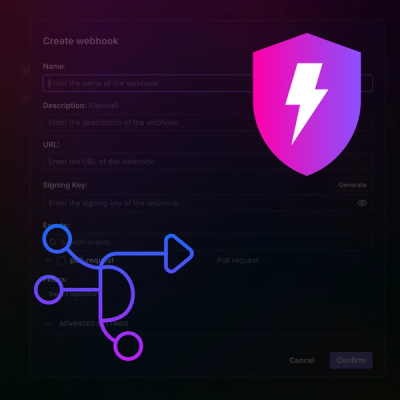
Product
Introducing Webhook Events for Pull Request Scans
Add real-time Socket webhook events to your workflows to automatically receive pull request scan results and security alerts in real time.
@storybook/server-webpack5
Advanced tools
Storybook for Server: View HTML snippets from a server in isolation with Hot Reloading.
Storybook for Server is a UI development environment for your plain HTML snippets rendered by your server backend. With it, you can visualize different states of your UI components and develop them interactively.

Storybook runs outside of your app. So you can develop UI components in isolation without worrying about app specific dependencies and requirements.
cd my-app
npx storybook@latest init -t server
To configure the server that Storybook will connect to, export a global parameter parameters.server.url in .storybook/preview.js:
export const parameters = {
server: {
url: `http://localhost:${port}/storybook_preview`,
},
};
The URL you connect to should have the ability to render a story, see server rendering below.
For more information visit: storybook.js.org
To write a story, use whatever API is natural for your server-side rendering framework to generate set of JSON or YAML files of stories analogous to CSF files (see the server-kitchen-sink example for ideas).
{
"title": "Component",
"parameters": {
"options": { "component": "my_widget" }
},
"stories": [
{
"name": "Default",
"parameters": {
"server": { "id": "path/of/your/story" }
}
}
]
}
In your .storybook/main.js you simply provide a glob specifying the location of those JSON files, e.g.
export default {
stories: ['../stories/**/*.stories.json'],
};
Notice that the JSON does not specify a rendering function -- @storybook/server will instead call your parameters.server.url with the story's server id appended.
For example the JSON story above is requivalent to the CSF3 definition:
export default {
title: 'Component',
parameters: {
options: {
component: 'my_widget',
},
},
};
export const Default = {
name: 'Default',
parameters: {
server: {
id: 'path/of/your/story"',
},
},
};
With the story HTML will be fetched from the server by making a GET request to http://localhost/storybook_preview/path/of/your/story`
In particular the View Component::Storybook gem provides a Ruby API for easily creating the above with a Ruby/Rails DSL (as well as providing a server rendering endpoint).
The server rendering side of things is relatively straightforward. When you browse to a story in the sidebar, Storybook will make a fetch request to ${parameters.server.url}/{parameters.server.id} and display the HTML that is returned.
You need to ensure the route in your server app renders the appropriate HTML when called in that fashion.
Many components are likely to be dynamic - responding to parameters that change their content or appearance. @storybook\server has two mechanisms for passing those parameters to the server - params and args. Parameters defined in this way are appended to the fetch url as query string parameters. The server endpoint is responsible for interpreting those parameters and vary the returned html appropriately
paramsStatic parameters can be defined using the params story parameter. For example suppose you have a Button component that has a label and color options:
{
"title": "Buttons",
"stories": [
{
"name": "Red",
"parameters": {
"server": {
"id": "button",
"params": { "color": "red", "label": "Stop" }
}
}
},
{
"name": "Green",
"parameters": {
"server": {
"id": "button",
"params": { "color": "green", "label": "OK" }
}
}
}
]
}
The Red and Green story HTML will be fetched from the urls server.url/controls/button?color=red&label=Stop and server.url/controls/button?color=green&label=OK
Like all story parameters server params can be defined in the default export and overridden in stories.
{
"title": "Buttons",
"parameters": {
"server": {
"params": { "color": "red" }
}
},
"stories": [
{
"name": "Default",
"parameters": {
"server": {
"id": "button",
"params": { "label": "Stop" }
}
}
},
{
"name": "Green",
"parameters": {
"server": {
"id": "button",
"params": { "color": "green", "label": "OK" }
}
}
}
]
}
args and ControlsDynamic parameters can be defined using args and the Controls addon
{
"title": "Buttons",
"stories": [
{
"name": "Red",
"parameters": {
"server": {
"id": "button"
}
},
"args": { "color": "red", "label": "Stop" }
},
{
"name": "Green",
"parameters": {
"server": {
"id": "button"
}
},
"args": { "color": "green", "label": "Go" }
}
]
}
Story args are passed to the server as url query parameters just like params except now they can be varied on the Controls addon panel.
Just like CSF stories we can define argTypes to specify the controls used in the controls panel. argTypes can be defined at the default or story level.
{
"title": "Buttons",
"argTypes": {
"color": { "control": { "type": "color" } }
},
"stories": [
{
"name": "Red",
"parameters": {
"server": {
"id": "button"
}
},
"args": { "color": "red", "label": "Stop" }
},
{
"name": "Green",
"parameters": {
"server": {
"id": "button"
}
},
"args": { "color": "green", "label": "Go" }
}
]
}
Storybook also comes with a lot of addons and a great API to customize as you wish. As some addons assume the story is rendered in JS, they may not work with @storybook/server (yet!).
Many addons that act on the manager side (such as backgrounds and viewport) will work out of the box with @storybook/server -- you can configure them with parameters written on the server as usual.
To configure controls, simple add args and argTypes keys to the story JSON much like you would CSF:
{
"title": "Controls",
"stories": [
{
"name": "Button",
"parameters": {
"server": { "id": "controls/button" }
},
"args": { "button_text": "Push Me", "color": "red" },
"argTypes": { "button_text": { "control": { "type": "color" } } }
}
]
}
The controls values will be added to your story URL as query parameters.
To use actions, use the parameters.actions.handles parameter:
{
"title": "Actions",
"stories": [
{
"name": "Button",
"parameters": {
"server": { "id": "actions/button" },
"actions": {
"handles": ["mouseover", "click .btn"]
}
}
}
]
}
For control over how @storybook/server fetches Html from the server you can provide a fetchStoryHtml function as a parameter. You would typically set this in .storybook/preview.js but it's just a regular Storybook parameter so could be overridden at the stories or story level.
// .storybook/preview.js
const fetchStoryHtml = async (url, path, params, context) => {
// Custom fetch implementation
// ....
return html;
};
export const parameters = {
server: {
url: `http://localhost:${port}/storybook_preview`,
fetchStoryHtml,
},
};
fetchStoryHtml should be an async function with the following signature
type FetchStoryHtmlType = (
url: string,
id: string,
params: any,
context: StoryContext
) => Promise<string | Node>;
parameters.server.urlparameters.server.idparameters.server.paramsand story argsLearn more about Storybook at storybook.js.org.
FAQs
Storybook for Server: View HTML snippets from a server in isolation with Hot Reloading.
The npm package @storybook/server-webpack5 receives a total of 108,124 weekly downloads. As such, @storybook/server-webpack5 popularity was classified as popular.
We found that @storybook/server-webpack5 demonstrated a healthy version release cadence and project activity because the last version was released less than a year ago. It has 12 open source maintainers collaborating on the project.
Did you know?

Socket for GitHub automatically highlights issues in each pull request and monitors the health of all your open source dependencies. Discover the contents of your packages and block harmful activity before you install or update your dependencies.

Product
Add real-time Socket webhook events to your workflows to automatically receive pull request scan results and security alerts in real time.

Research
The Socket Threat Research Team uncovered malicious NuGet packages typosquatting the popular Nethereum project to steal wallet keys.

Product
A single platform for static analysis, secrets detection, container scanning, and CVE checks—built on trusted open source tools, ready to run out of the box.